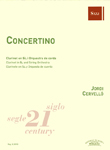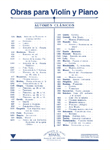El cementiri marí
Pack de 10 particellas para coro
Coro mixto
BENGUEREL, XavierReg.: B.3829b
175,00 €
P.V.P. (VAT included 4%)
Add to cart
- Translation: BENGUEREL I LLOBET, Xavier
- Ensemble: Symphonic orchestra: With voice/choir.
Choir: With accompaniment; Mixt. - Genres: Classical / contemporary: Choir; Symphonic.
- Lyric author: VALÉRY, Paul
- Language: Catalán/Francés
- Product format: Particellas
- Difficulty level: Advanced-superior
- Period: 2nd half S. XX - XXI
- Publishing house: Editorial Boileau
- Collection: Siglo XXI
- No. of pages: 40(x10)
- Measure: 0,00 x 0,00 cm
- Lenght: 45'
- ISMN: 979-0-3503-4202-8
- Available in digital: No
- Available for rent: No
Pack of 10 parts for choir
Looking back on the direction Xavier Benguerel (Barcelona, 1931) has taken in his compositions since the early 1980s, it becomes apparent that his chamber opera Spleen (1984) marks the beginning of a new period, characterized by a move towards increasingly large-scale works; a purging of his musical language, which developed in an independent direction from established models and schools; a striving for greater dramatic, expressive and communicative impact; and a great variety of stimulae, subject matter and motives. We can observe these traits in the diversity and scale of such works as Llibre Vermell [Red Book] (1988), Rèquiem a la memòria de Salvador Espriu [Requiem in memory of Salvador Espriu] (1989), Te Deum (1993) dedicated to Josep M. Subirachs, the Concerto para piano (2004), the opera Yo, Dalí [I, Dalí] (2011) and the song cycle based on Les Fleurs du Mal for soprano, baritone, children’s chorus and orchestra.
Another work from this period, El cementiri marí [The graveyard by the sea], for reader, choir and orchestra, is particularly unique. It is based on Paul Valéry’s (1871-1945) 1920 poem by the same name, of which Berenguerel’s father, novelist Xavier Berenguerel y Llobet (1905-1990) published five (!) separate translations in the course of his career. The poem had thus been a presence in Berenguerel’s life since his youth (which he spent in Santiago, Chile), when his father’s first edition, with illustrations by Carles Fontserè, was published.
Although he had long intended to compose a setting for this major 20th-century poem, it was only in 2014 that Berenguerel undertook the challenge. The graveyard by the sea is not only the most important and best-known work by Valéry; it is also one of the most ambitious, complex, and evocative lyric poems ever written, and has inspired an overwhelming amount of literary criticism. The poem consists of 24 six-line stanzas in decasyllabic verse. This was, incidentally, an “extremely rarely used meter since the Medieval chansons de geste, Marot, and Ronsard (…), decasyllables, as used by the latter, [had] a caesura and accent on the fourth syllable,” according leading scholar Gustave Cohen. Or, in Valéry’s words, it is “an empty rhythmic figure, or rather one full of empty syllables, with which I was obsessed for a time.”
Following an evocative quote from Pindar («O mon âme, n’aspire pas à la vie immortelle/mais épuise le champ du posible»1, in Aimé Puech’s translation), Valéry undertakes an intense metaphysical reflection on body and soul, mortality and immortality, time and awareness, life and death. Perhaps one of the most striking aspects of this “monologue of the self” (to use Valéry’s term) is its dramatic unfolding over four hypothetical acts in the following groupings of stanzas: 1-4 (the hypnotic presence of the unmoving sea), 5-9 (the emergence of awareness in time), 9-19 (reflection on death and rejection of immortality of the soul) and, lastly, 19-24 (a decisive choice in favor of life, bodily movement, poetic creation and action: “le vent se lève !... il faut tenter de vivre !”2 in the best-known line of the poem).
May this brief outline help us relate to Valéry, as we bear his words in mind: “In the universe of poetry, every moment must consummate an indefinable union between feeling and meaning. Because of this, in a certain continuous manner, the composition cannot hide itself away in any moment but that of its execution. There is no separate time for the “form” and another for the “content”; in the lyric genre, composition is not merely opposed to disorder or disproportion, but to de-composition. If sense and sound (or form and content) can be easily dissociated, the poem breaks down.”
I would say it is imminently fitting, and in full accord with Valéry (especially as regards the meaning of composition and the inseparable union of sound and sense) that Benguerel has undertaken to set this poem to music. In fact, it is as if the work were returning to its original state: in the words of Gustave Cohen, the poem “was entirely conceived of as a kind of symphony, whose melodious phrases resounded within it, denuded of words, like a sound structure that framed floating images.”
Benguerel has responded to the challenge of setting this text, as long as it is dense, by giving it total prominence. Performed in his father’s translation in Catalonia and in the original French elsewhere, each stanza is read separately, in order to allow it to resonate with the listener while engendering a musical response that is both discreet and effectively revealing. Thus each stanza is allowed to shine on its own, while the music (in chamber orchestra format to match the tone and essence of the poem) comes in to prepare us for the next, with occasional input from a choir, which (ah, Debussy!) is treated as another instrument among the rest.
For Benguerel, then, it is equally as essential to preserve the text’s intelligibility as the musical structure of the piece. The end goal is to use word and sound (poem and music) to form an inseparable, perfectly amalgamated whole. This is how the work fulfills its three-faceted objective: to breathe symphonic life into one of the greatest poems of the 20th century, to pay tribute to one of the poem’s greatest interpreters and, last but not least, to capture the composer’s profound admiration for early 20th-century French poetry and music.
Àlex SUSANNA









